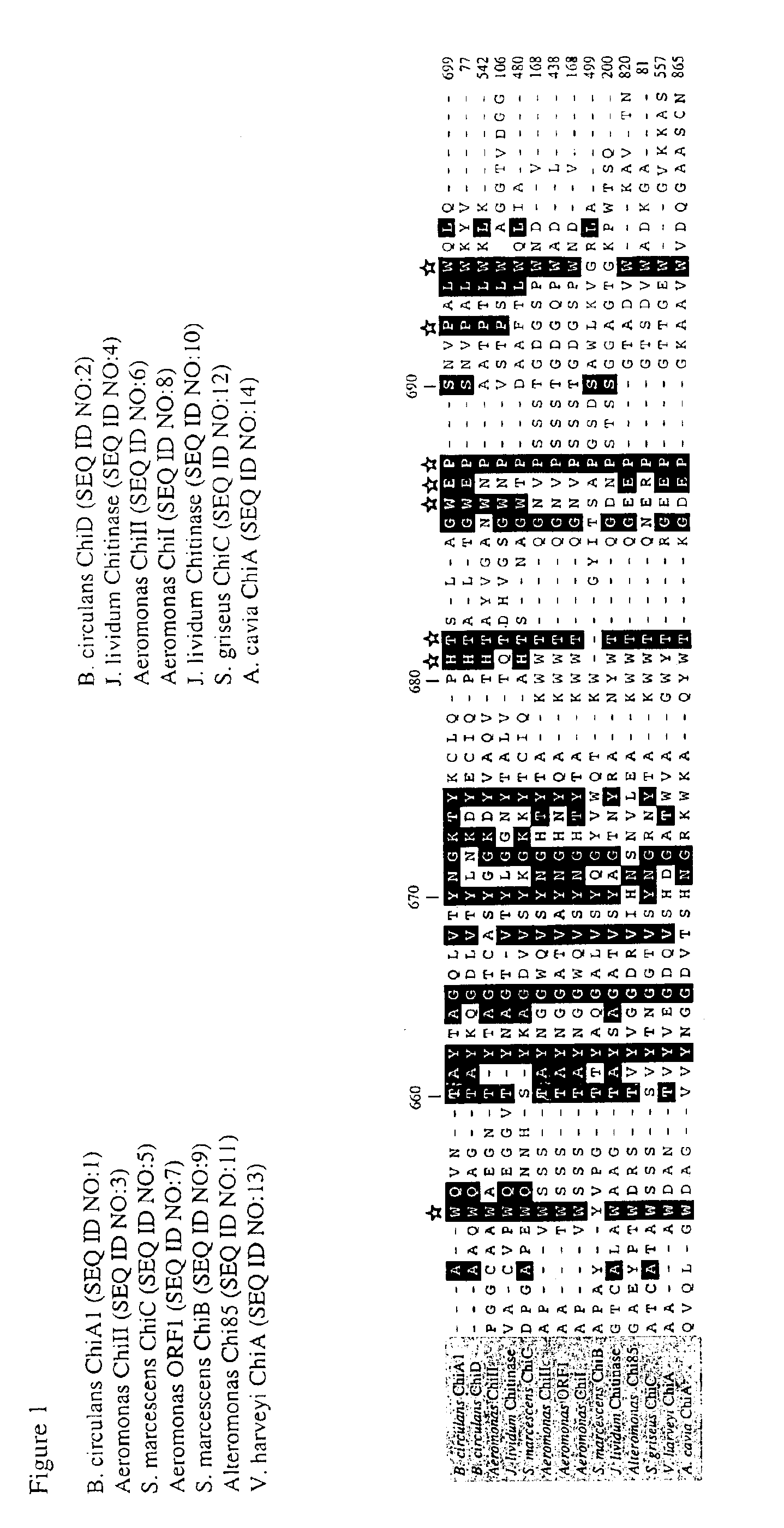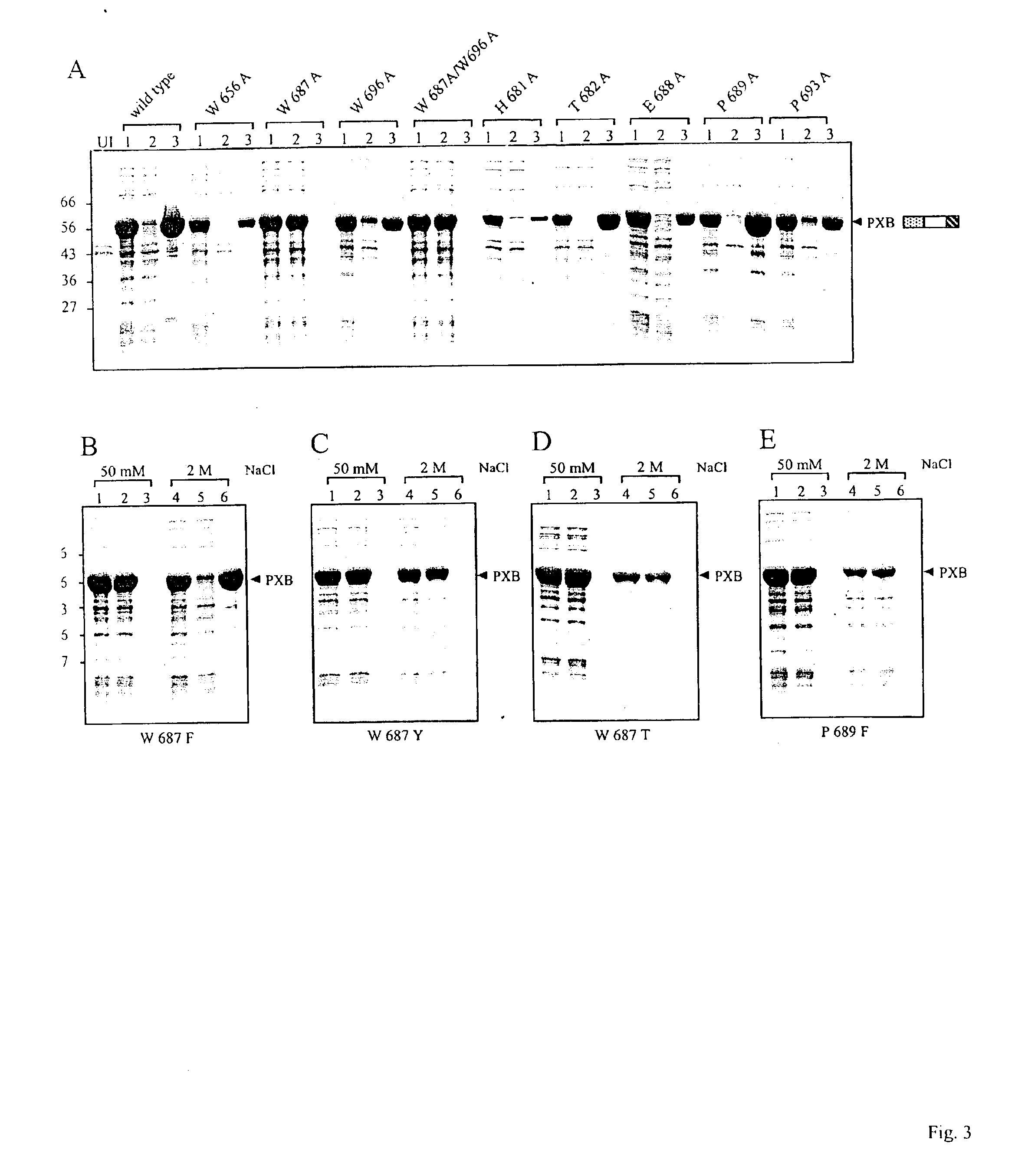Modified chitin binding domain and uses thereof
a technology of chitin and binding domain, which is applied in the field of modified chitin binding domain, can solve the problems of natural lack of hydrolytic activity and limit the general utility of the produ
- Summary
- Abstract
- Description
- Claims
- Application Information
AI Technical Summary
Benefits of technology
Problems solved by technology
Method used
Image
Examples
example i
Plasmid Construction
[0081]The vector pPXB expresses a tripartite fusion protein consisting of the Dirofilaria immitis paramyosin ΔSa / I fragment (Steel et al., J. Immunol., 145:3917-3923 (1990)) followed by the Mxe GyrA intein of Mycobacterium xenopi (Mxe intein) and the wild type CBD from Bacillus circulans WL-12 fused to the C-terminus of the intein (Evans et al., Biopolymers 51:333-342 (1999a)). The sequence encoding human granulocyte-macrophage colony-stimulating factor (hGM-CSF) (Cantrell et al., Proc. Natl. Acad. Sci. USA, 82:6250-6254 (1985); Mingsheng et al., J. Biotechnol. 1995:157-162 (1995)) was amplified by polymerase chain reaction (PCR) using hGM-CSF cDNA (ATCC-39754) as template and the primers: 5′-CTC GAGCATATGGCACCCGCCCGCTCGC-3′ (SEQ ID NO: 17) and 5′-CGTGGTTGCTCTTCCGCACTCCTGGACTGGCTCCCAGCAG-3′ (SEQ ID NO:18). The resulting product was cloned into pTWIN1 vector (Evans et al., J. Biol. Chem., 274:18359-18363 (1999b)) using NdeI and SapI sites yielding pGM-CSF-XB. Expr...
example ii
[0082]Escherichia coil strain ER2566 (New England Biolabs, Beverly, Mass.; Chong et al., Gene 192:271-281 (1997)), harboring pPXB or its mutant derivatives, was grown at 37° C. in 1 liter of LB medium containing 100 μg / ml of ampicillin to an A600 of 0.5-0.7. The culture was induced with 0.3 mM isopropyl-β-D-thiogalactoside (IPTG) at 30° C. for 3 hours or at 16° C. overnight under the control of the T7 promoter (Studier et al., Methods Enzymol., 185:60-89 (1990)). The proteins expressed from pPXB are referred to as PXB fusion proteins in our study. The binding assay was carried out by resuspension of the cell pellet in 20 mM Tris-HCl (pH 8) containing 2 M or 50 mM NaCl. Following sonication of the resuspended cell pellet, debris was removed by centrifugation at 4,000×g for 30 minutes. Clarified supernatants were loaded at 4° C. onto a column with a 3 ml bed volume of beads made of insoluble chitin (New England Biolabs, Beverly, Mass.) previously equilibra...
example iii
Assay for NaCl-Dependent Chitin-Binding and Elution
[0083]Expression of the PXB (W687F) fusion protein was conducted as described above. Binding of the PXB (W687F) mutant protein to chitin was carried out in 20 mM Tris-HCl (pH 8) containing either 2, 1, 0.5 or 0.05 M NaCl. Appropriate buffer was used for resuspension of the cell pellet and wash of chitin resin after loading. For the elution assay, resuspension of cell pellet and sonication were performed using the 20 mM Tris-HCl (pH 8) buffer containing 2 M NaCl. After the centrifugation step of the cell extract, the supernatant was loaded onto a chitin column previously equilibrated with buffer containing 20 mM Tris-HCl (pH 8) and 2 M NaCl. The PXB protein was eluted with 20 mM Tris-HCl (pH 8) buffer containing either 1 M, 0.5 M, 0.1 M or 50 mM NaCl. Thirty 1-ml fractions were collected. NaCl concentration of the 50 mM NaCl-eluted fraction was shifted back to 2 M in order to test whether binding was a reversible phenomenon. Recombin...
PUM
| Property | Measurement | Unit |
|---|---|---|
| pH | aaaaa | aaaaa |
| pH | aaaaa | aaaaa |
| bed volume | aaaaa | aaaaa |
Abstract
Description
Claims
Application Information
 Login to View More
Login to View More - R&D
- Intellectual Property
- Life Sciences
- Materials
- Tech Scout
- Unparalleled Data Quality
- Higher Quality Content
- 60% Fewer Hallucinations
Browse by: Latest US Patents, China's latest patents, Technical Efficacy Thesaurus, Application Domain, Technology Topic, Popular Technical Reports.
© 2025 PatSnap. All rights reserved.Legal|Privacy policy|Modern Slavery Act Transparency Statement|Sitemap|About US| Contact US: help@patsnap.com



